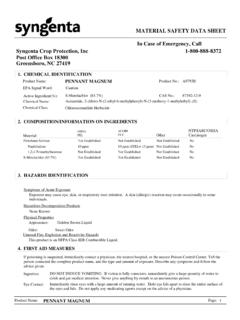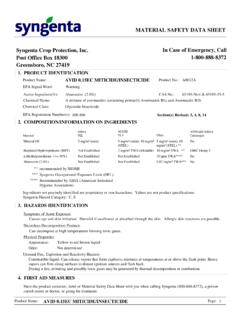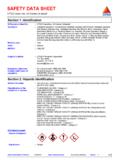Transcription of MATERIAL SAFETY DATA SHEET Syngenta Crop Protection, …
1 MATERIAL SAFETY data SHEET 1. PRODUCT IDENTIFICATION 2. COMPOSITION/INFORMATION ON INGREDIENTS 3. HAZARDS IDENTIFICATION 4. FIRST AID MEASURESP roduct No.: A12460 AEPA Signal Word:CautionSymptoms of Acute ExposureCan cause eye, skin and respiratory passage irritation. Allergic reactions are possible. Harmful if inhaled or to high vapor levels may cause headache, dizziness, numbness, nausea, incoordination, or other central nervous system Decomposition ProductsCan decompose at high temperatures forming toxic PropertiesAppearance:Dark brown liquid, free of sedimentOdor:AromaticUnusual Fire, Explosion and Reactivity HazardsDuring a fire, irritating and possibly toxic gases may be generated by thermal decomposition or the product container, label or MATERIAL SAFETY data SHEET with you when calling Syngenta (800-888-8372), a poison contol center or doctor, or going for Name:FUSILADE II TURF & ORNAMENTALEPA Registration Number(s):100-1084 Ingredients not precisely identified are proprietary or non-hazardous.
2 Values are not product (s) Revised: 2, 3, 4, 5, 6, 8, 15 Syngenta Crop Protection, Office Box 18300In Case of Emergency, Call1-800-888-8372 Greensboro, NC 27419 CAS No.:79241-46-6 Chemical Name:Butyl(RS)-2-[4-[[5-(trifluoromethyl )-2-pyridinyl]oxy]phenoxy]propanoateChem ical Class:A post emergence herbicideActive Ingredient(%):Fluazifop-P-Butyl Technical ( )MaterialNTP/IARC/OSHA CarcinogenOtherOSHAPELACGIHTLVSee "Toxicity", Sec. 11 Naphthalene (<= )10 ppm TWA 10 ppm TWA (skin)10 ppm TWA**NoPetroleum distillates, light paraffinic Not EstablishedNot EstablishedNot EstablishedNoPetroleum Solvent Not EstablishedNot Established100 mg/m (15 ppm) TWA *NoFluazifop-P-Butyl Technical ( ) Not EstablishedNot mg/m TWA**recommended by manufacturer**recommended by NIOSH** Syngenta Occupational Exposure Limit (OEL)Page:1 Product Name: FUSILADE II TURF & ORNAMENTALU pper: % Not ApplicableLower: % Not Applicable 5.
3 FIRE FIGHTING MEASURESIf swallowed: call Syngenta (800-888-8372), a poison control center or doctor immediately for treatment advice. Do not give any liquid to the person. Do not induce vomiting unless told to do so after calling 800-888-8372 or by a poison control center or doctor. Do not give anything by mouth to an unconscious in eyes: Hold eye open and rinse slowly and gently with water for 15-20 minutes. Remove contact lenses, if present, after 5 minutes, then continue rinsing eye. call Syngenta (800-888-8372), a poison control center or doctor for treatment on skin or clothing: Take off contaminated clothing. Rinse skin immediately with plenty of water for 15-20 minutes. call Syngenta (800-888-8372), a poison control center or doctor for treatment inhaled: Move person to fresh air. If person is not breathing, call 911 or an ambulance, then give artificial respiration, preferably mouth-to-mouth if possible.
4 call Syngenta (800-888-8372), a poison control center or doctor for further treatment to PhysicianMedical Condition Likely to be Aggravated by ExposureNone and ExplosionUnusual Fire, Explosion and Reactivity HazardsDuring a fire, irritating and possibly toxic gases may be generated by thermal decomposition or Case of FireUse dry chemical, foam or CO2 extinguishing media. Wear full protective clothing and self-contained breathing apparatus. Evacuate nonessential personnel from the area to prevent human exposure to fire, smoke, fumes or products of combustion. Prevent use of contaminated buildings, area, and equipment until decontaminated. Water runoff can cause environmental damage. If water is used to fight fire, dike and collect :Not Applicable> 212 F (TCC) Not AvailableFlash Point (Test Method):Flammable Limits (% in Air):Autoignition Temperature:Ingestion:Eye Contact:Skin Contact:Inhalation: 6.
5 ACCIDENTAL RELEASE MEASURES 7. HANDLING AND STORAGEIn Case of Spill or LeakStore the MATERIAL in a well-ventilated, secure area out of reach of children and domestic animals. Do not store food, beverages or tobacco products in the storage area. Prevent eating, drinking, tobacco use, and cosmetic application in areas where there is a potential for exposure to the MATERIAL . Wash thoroughly with soap and water after the spill at its source. Contain the spill to prevent from spreading or contaminating soil or from entering sewage and drainage systems or any body of water. Clean up spills immediately, observing precautions in Protective Equipment Section. Cover entire spill with absorbing MATERIAL and place into compatible disposal container. Scrub area with hard water detergent ( commercial products such as Tide, Joy, Spic and Span). Pick up wash liquid with additional absorbent and place into compatible disposal container.
6 Once all MATERIAL is cleaned up and placed in a disposal container, seal container and arrange for is no specific antidote if this product is petroleum distillate - vomiting may cause aspiration pneumonia. 8. EXPOSURE CONTROLS/PERSONAL PROTECTIONP revent eating, drinking, tobacco usage and cosmetic application in areas where there is a potential for Ingestion:THE FOLLOWING RECOMMENDATIONS FOR EXPOSURE CONTROLS/PERSONAL PROTECTION ARE INTENDED FOR THE MANUFACTURE, FORMULATION, PACKAGING AND USE OF THIS PRODUCT. FOR COMMERCIAL APPLICATIONS AND/OR ON-FARM APPLICATIONS CONSULT THE PRODUCT :2 Product Name: FUSILADE II TURF & ORNAMENTAL 11. TOXICOLOGICAL INFORMATIONA cute Toxicity/Irritation Studies (Finished Product)Reproductive/Developmental EffectsIngestion:Dermal:Inhalation:Eye Contact:Skin Contact:Skin Sensitization:Practically Non-ToxicPractically Non-ToxicSlightly ToxicOral (LD50 Rat) : Slightly Irritating (Rabbit)Moderately Irritating (Rabbit)See "Other Toxicity Information", Sec.
7 11 Dermal (LD50 Rat) : Inhalation (LC50 Animal Not Available) : > 5,000 mg/kg body weight> 2,000 mg/kg body weight mg/l air - 4 hours 9. PHYSICAL AND CHEMICAL PROPERTIESDark brown liquid, free of sedimentAromatic 10. STABILITY AND REACTIVITYS tability:Stable under normal use and storage Polymerization:Will not to Avoid:None decompose at high temperatures forming toxic Point:Boiling Point:Specific Gravity/Density:Not ApplicableNot g/ml @ 68 F (20 C) Appearance:Odor: (1% w/w dilution in deionized water)Solubility in H2 OVapor Pressureexposure to the MATERIAL . Wash thoroughly with soap and water after eye contact is likely, use chemical splash goggles. Where contact is likely, wear chemical-resistant (such as nitrile or butyl) gloves, coveralls, socks and chemical-resistant footwear. For overhead exposure, wear chemical-resistant process enclosures, local exhaust ventilation, or other engineering controls to keep airborne levels below exposure limits.
8 A NIOSH-certified combination air-purifying respirator with an N, P or R 95 or HE class filter and an organic vapor cartridge may be permissible under certain circumstances where airborne concentrations are expected to exceed exposure limits. Protection provided by air-purifying respirators is limited. Use a pressure demand atmosphere-supplying respirator if there is any potential for uncontrolled release, exposure levels are not known, or under any other circumstances where air-purifying respirators may not provide adequate Contact:Skin Contact:Inhalation:Hazardous Decomposition Products:Materials to Avoid:Oxidizing Technical:In a 3-generation reproductive study in rats, effects included reductions in weight gain, fetal weight, ossification, testicular weight, spleen weight, increased prostate weight and gestation length. No Effect Level (NEL) was 1 mg/kg/day. Fetotoxic effects seen in the rabbit, including reduced fetal weight and reduced ossification at higher doses.
9 No Effect Level (NEL) was 30 mg/kg/day in rabbits. The NEL for teratogenic effects is at least 10/mg/day in the rat, with Almost insoluble in water (1 mg/l @ pH 5 - )Fluazifop-P-Butyl Technical: Fluazifop-P-Butyl Technical: x 10(-7) mmHg @ 68 F (20 C)Page:3 Product Name: FUSILADE II TURF & ORNAMENTAL 12. ECOLOGICAL INFORMATIONC hronic/Subchronic Toxicity StudiesCarcinogenicityToxicity of Other ComponentsSummary of EffectsEco-Acute Toxicity Target OrgansOther Toxicity InformationRepeated and/or prolonged contact may cause skin IngredientsInert Ingredientsdiaphragmatic hernia at higher doses. Not teratogenic at highest dose tested in rabbits (90 mg/kg/day). While fluazifop-p-butyl is fetotoxic when fed to pregnant rats, human exposure data has concluded that female formulation workers are not at increased risk of fetotoxic effects when skin protection measures are Technical:Chronic toxicity studies in rodents have shown liver changes (cellular hypertrophy).
10 The No Effect Level (NEL) in rats is 10 ppm ( mg/kg/day). Long term feeding studies in dogs produced a range of potentially serious effects at high dose rates (red cell, bone marrow and lymphadenopathy changes and liver and spleen damage) with a No Effect Level of 25 mg/ specific neurotoxicity tests have been conducted on fluazifop-p-butyl. However, there was no evidence of neurotoxicity in acute, subchronic or chronic Technical:Laboratory studies show no evidence that fluazifop-p-butyl is a carcinogen. Specific rat and mouse lifetime studies on fluazifop butyl (a related compound) showed no carcinogenic effects (highest doses 250 ppm rat and 80 ppm mouse).Exposure to naphthalene can cause cataracts, liver damage, kidney failure, respiratory failure, hematuria, anemia, damage to red blood cells, leukocytosis, or Status:NTP: Anticipated CarcinogenIARC: Group 2B Possible Human CarcinogenNaphthalene (<= )Inhalation of vapors at high concentrations can cause central nervous system effects (dizziness, headache), irritation to eyes or respiratory Solvent May cause respiratory tract irritation.








![[Decal] - cdms.net](/cache/preview/e/d/3/7/9/d/0/9/thumb-ed379d0982d91120ea892142998ff208.jpg)


